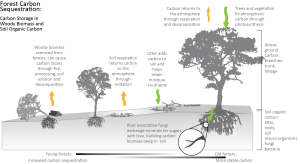Think of the Earth like your house on a holiday, filled with so many guests, you are running out of room for everyone to sit. Imagine there is one person turning up the heat even though your house is already extra warm from all of your guests. We will call that one person, Carbon Dioxide. Just like too much heat in your home can make all of your guests uncomfortable, excess Carbon Dioxide in Earth’s atmosphere results in the planet warming up.
Now think of automatic air-conditioning in your home, it kicks on every time your house gets too hot. A process called Carbon Sequestration does this for the Earth. Every time there is excess Carbon Dioxide in the air, warming the planet, Carbon Sequestration helps remove the excess Carbon Dioxide from the air, managing Earth’s “thermostat”. Ensuring that the “house’s” temperature is comfortable enough for everyone.
We understand how Carbon Sequestration plays a pivotal role in regulating Earth’s “thermostat”. Let’s talk about what contributes to Carbon Sequestration, how this process works and the various methods used to improve Earth’s temperature naturally.
The 3 C’s: Climate Change, Carbon Dioxide and Carbon Sequestration
Some key terms you need to know in order to understand Carbon Sequestration are:
Climate Change: occurs when greenhouse gas emissions wrap around the Earth and trap in the sun’s heat, causing the temperature to rise.
Carbon Dioxide: is a colorless, odorless gas produced by burning carbon and organic compounds and by respiration. It is naturally present in air and is absorbed by plants in photosynthesis. This process is called, the carbon cycle:

Did you know, carbon dioxide is the most commonly produce greenhouse gas? Carbon Dioxide forms from daily practices like cooling, heating and lighting. Organizations like EPA monitor how the United States contributed to greenhouse gas emission, specifically our carbon dioxide emissions. In 2022, carbon dioxide emissions totaled 79.7% of total emissions in the United States:

Given Carbon Dioxide results for more than 75% of the total United States greenhouse gas emissions, carbon sequestration is a promising solution to act as Earth’s natural mechanism to remove excess carbon dioxide in the atmosphere. Climate Change, Carbon Dioxide and carbon sequestration form a interconnected system, if one changes they all change. Understanding how they connect is crucial for carbon sequestration to work effectively to build a sustainable future.
The Process of Carbon Sequestration
Carbon sequestration is the process of capturing and storing atmospheric carbon dioxide. The purpose behind this process is to stabilize carbon in solid and dissolved forms, so the Earth’s temperate doesn’t get too hot. There are 3 critical processes that take place in each type of Carbon Sequestration:
- Capture: The CO2 needs to be captured for storage and is separated from other gases.
- Transport: The CO2 is then compressed and transported using pipelines, road transport or ships to a site for storage.
- Storage: Finally, the CO2 is injected into rock formations deep underground for permanent storage.
The Types of Carbon Sequestration
Scientists are using different four main types of Carbon Sequestration to solve the ongoing climate change issues. Each type has its own distinct characteristics and process.
Biological Carbon Sequestration
Carbon dioxide is found in vegetation in places like oceans, soil, forests and grasslands. Forests specifically, hold 25 percent of global carbon emissions in plant-rich landscapes such as forests, grasslands and rangelands. Trees in forest act as paper towels for atmospheric carbon. If you spill water on the counter and use a paper towel, it absorbs all the water it can until you have to use another one. Trees do the same, but with carbon dioxide in the atmosphere. Trees use the carbon sequestration process to capture carbon dioxide and hold carbon as an effective method of reducing atmospheric concentrations of CO2 pictured here:

Geological Carbon Sequestration
Another way carbon dioxide is captured and stored is through, Geological Carbon Sequestration, in underground rock formations. For example, sandstone and limestone are injected with carbon when industrial plants like steel mills and power plants emit carbon dioxide. Other ways carbon dioxide is injected is through depleted oil and gas reservoirs to improve the recovery of remaining oil and gas. Large volumes of carbon dioxide can be stored using this method. In recent news, Ricardo Pereira, discovered a potential off shore extinct volcano in Portugal that could store gigatons of carbon dioxide.

If this study is successful, this discovery would help store the equivalent of ~24-125 years of the country’s industrial emissions.
Exxon Mobil is a global leader of carbon capture and storage using a geological method. They capture carbon dioxide and inject it into geologic formations deep underground for safe, secure and permanent storage. Their goal was to reduce emissions from sectors like refining, chemicals, cement, steel and power generation. They have now more than 1,500 miles of CO2 pipeline owned and operated – largest network in the U.S. and have the potential to reduce CO2 emissions by > 100 million metric tons a year.
Technological Carbon Sequestration
This is a relatively newer process which involves using technology to capture and store CO2 or make it into a resource.
Graphene production: Graphene is a material that is extracted from graphite and is made up of pure carbon, an example is the lead of a pencil. Carbon dioxide is used as a raw material to produce graphene, a technological material. You can find Graphene in everyday items like your smart phones and other tech devices.
Direct Air Capture (DAC): is when carbon is captured directly from the air. This process is energy intensive and expensive. This technique can be effective, but is still too costly to implement on a mass scale. There are 3 basic steps to DAC that produce 2 outputs: concentrated CO2 and filtered air:

Engineered molecules: Molecules are engineered to create new kinds of compounds capable of singling out and capturing carbon dioxide from the air. The engineered molecules act as a filter solely for carbon dioxide.
Industrial Carbon Sequestration
This method involves capturing carbon dioxide released from industrial processes through pre-combustion, post-combustion, and oxyfuel. This is the least common type of sarbon sequestration.
Pre-combustion capture: During pre-combustion carbon capture before fuel combustion. Benefits of pre-combustion, include high efficiency and relatively easier carbon removal from fossil fuels.

Post-combustion capture: during, post-combustion carbon capture, CO is captured snf removed before they exit smoke stacks from flue gasses after combustion. This process is common for retrofitting existing power plants and has been proven to recover CO2 at a rate up to 800 tonnes/day.

Oxyfuel combustion: Oxygen is used to burn fuel, resulting in a flue gas primarily composed of CO.

How Carbon is Stored in Hardwood
Hardwood trees sequester carbon through photosynthesis by absorbing carbon dioxide from the atmosphere and converting it into glucose and oxygen. Hardwoods like oak and maple store substantial amounts of carbon during their lifespand. This is due to their density and longevity. When these trees are produced into hardwood products like furniture, flooring and cabinets they continue to store carbon. Carbon is also transferred through leaf litter and root decomposition. This process contributes to the biological carbon sequestration mentioned above.
The Benefits of Carbon Sequestration
Carbon Sequestration is an effective solution to reduce greenhouse gas emissions and mitigate climate change, by removing carbon dioxide in the atmosphere. This process stabilizes the Earth’s temperature and directly impacts the climate change and the natural events associated with it like wildfires hurricanes, rising sea levels and disrupted ecosystems. Renewable and energy efficient ways of living have been developed by scientists leveraging different processes and types of carbon sequestration.
Importance of Carbon Sequestration in Forestry
Over the last 40 years, forests have absorbed 25% of human carbon emissions, slowing the rate of climate change. The longer trees live for, the more carbon dioxide they hold.
The 5 main benefits carbon sequestration in forestry are:
Time: The longer a forest is alive, the more carbon it will hold.
Purification: Water and air. One tree can take in 10 pounds of pollution and produce enough oxygen for 2 people.
Flood Control: Reducing erosion and runoff
Resources: Trees protect resources that humans rely on heavily like food, medicine and landscaping materials.
Dry Land: If there are not enough trees this can result in to much sun exposure and lead to dry soil, more carbon and dead organisms.
Restoring forests with high carbon density, planting diverse tree species to maximize biodiversity, dividing land zones and leveraging a forest’s carbon cycle are a few ways we can maximize the carbon sequestration benefits for forests.

Gutchess Lumber’s Sustainable Forestry and Carbon Sequestration
In 2024, our goal is to create a greener and more sustainable future by practicing responsible forestry management. This practice enables natural forest regeneration and creates climate change-resilient forests, which are known to be more resilient.

Our commitment to minimizing carbon dioxide begins in our forests and supports the flow of carbon that is sequestered in the timber to the hardwood lumber products we produce. Hardwood products can store carbon for decades, centuries, or indefinitely in some cases. By using hardwood products, you can help to mitigate climate change.
You are supporting environmental sustainability when you buy Gutchess hardwood. We also offer Forest Management Consulting, to assist other forest landowners in maximizing their long term returns through professional forest management. We will create a greener future for our customers, for our families, and for our planet.

